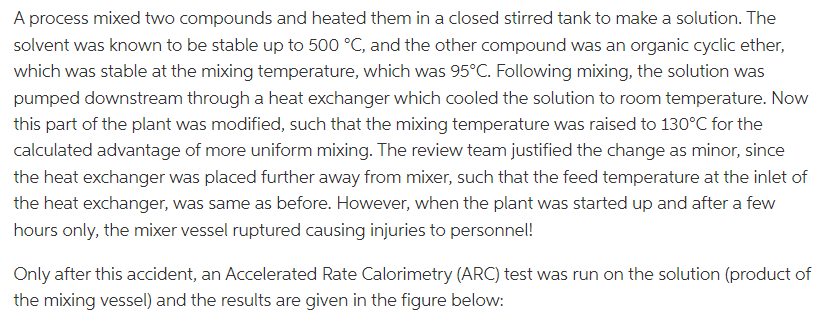A process mixed two compounds and heated them in a closed stirred tank to make a solution. The solvent was known to be stable up to 500 °C, and the other compound was an organic cyclic ether, which was stable at the mixing temperature, which was 95°C. Following mixing, the solution was pumped downstream through a heat exchanger which cooled the solution to room temperature. Now this part of the plant was modified, such that the mixing temperature was raised to 130°C for the calculated advantage of more uniform mixing. The review team justified the change as minor, since the heat exchanger was placed further away from mixer, such that the feed temperature at the inlet of the heat exchanger, was same as before. However, when the plant was started up and after a few hours only, the mixer vessel ruptured causing injuries to personnel! Only after this accident, an Accelerated Rate Calorimetry (ARC) test was run on the solution (product of the mixing vessel) and the results are given in the figure below:
A process mixed two compounds and heated them in a closed stirred tank to make a solution. The solvent was known to be stable up to 500 °C, and the other compound was an organic cyclic ether, which was stable at the mixing temperature, which was 95°C. Following mixing, the solution was pumped downstream through a heat exchanger which cooled the solution to room temperature. Now this part of the plant was modified, such that the mixing temperature was raised to 130°C for the calculated advantage of more uniform mixing. The review team justified the change as minor, since the heat exchanger was placed further away from mixer, such that the feed temperature at the inlet of the heat exchanger, was same as before. However, when the plant was started up and after a few hours only, the mixer vessel ruptured causing injuries to personnel! Only after this accident, an Accelerated Rate Calorimetry (ARC) test was run on the solution (product of the mixing vessel) and the results are given in the figure below:
Introduction to Chemical Engineering Thermodynamics
8th Edition
ISBN:9781259696527
Author:J.M. Smith Termodinamica en ingenieria quimica, Hendrick C Van Ness, Michael Abbott, Mark Swihart
Publisher:J.M. Smith Termodinamica en ingenieria quimica, Hendrick C Van Ness, Michael Abbott, Mark Swihart
Chapter1: Introduction
Section: Chapter Questions
Problem 1.1P
Related questions
Question

Transcribed Image Text:A process mixed two compounds and heated them in a closed stirred tank to make a solution. The
solvent was known to be stable up to 500 °C, and the other compound was an organic cyclic ether,
which was stable at the mixing temperature, which was 95°C. Following mixing, the solution was
pumped downstream through a heat exchanger which cooled the solution to room temperature. Now
this part of the plant was modified, such that the mixing temperature was raised to 130°C for the
calculated advantage of more uniform mixing. The review team justified the change as minor, since
the heat exchanger was placed further away from mixer, such that the feed temperature at the inlet of
the heat exchanger, was same as before. However, when the plant was started up and after a few
hours only, the mixer vessel ruptured causing injuries to personnel!
Only after this accident, an Accelerated Rate Calorimetry (ARC) test was run on the solution (product of
the mixing vessel) and the results are given in the figure below:
Expert Solution
This question has been solved!
Explore an expertly crafted, step-by-step solution for a thorough understanding of key concepts.
Step by step
Solved in 2 steps

Recommended textbooks for you

Introduction to Chemical Engineering Thermodynami…
Chemical Engineering
ISBN:
9781259696527
Author:
J.M. Smith Termodinamica en ingenieria quimica, Hendrick C Van Ness, Michael Abbott, Mark Swihart
Publisher:
McGraw-Hill Education

Elementary Principles of Chemical Processes, Bind…
Chemical Engineering
ISBN:
9781118431221
Author:
Richard M. Felder, Ronald W. Rousseau, Lisa G. Bullard
Publisher:
WILEY

Elements of Chemical Reaction Engineering (5th Ed…
Chemical Engineering
ISBN:
9780133887518
Author:
H. Scott Fogler
Publisher:
Prentice Hall

Introduction to Chemical Engineering Thermodynami…
Chemical Engineering
ISBN:
9781259696527
Author:
J.M. Smith Termodinamica en ingenieria quimica, Hendrick C Van Ness, Michael Abbott, Mark Swihart
Publisher:
McGraw-Hill Education

Elementary Principles of Chemical Processes, Bind…
Chemical Engineering
ISBN:
9781118431221
Author:
Richard M. Felder, Ronald W. Rousseau, Lisa G. Bullard
Publisher:
WILEY

Elements of Chemical Reaction Engineering (5th Ed…
Chemical Engineering
ISBN:
9780133887518
Author:
H. Scott Fogler
Publisher:
Prentice Hall


Industrial Plastics: Theory and Applications
Chemical Engineering
ISBN:
9781285061238
Author:
Lokensgard, Erik
Publisher:
Delmar Cengage Learning

Unit Operations of Chemical Engineering
Chemical Engineering
ISBN:
9780072848236
Author:
Warren McCabe, Julian C. Smith, Peter Harriott
Publisher:
McGraw-Hill Companies, The